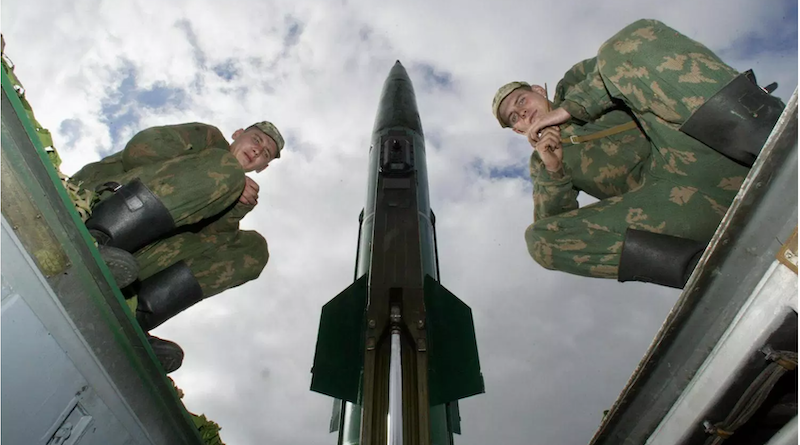Why the INF Treaty Is Dead, and Russia Is the Biggest Loser
By Chris Miller, Assistant Professor of International History at The Fletcher School of Law and Diplomacy at Tufts University
On Aug. 2, one of the last pillars of the Cold War-era arms control regime came tumbling down. The Intermediate-Range Nuclear Forces (INF) Treaty, which banned the United States and Russia from fielding land-based missiles with a range between 500 and 5,500 kilometers, is no more. Now only one major bilateral agreement, New START, limits the U.S. and Russian nuclear arsenals. In turn, a new arms race looks likely.
Washington and Moscow have predictably blamed the other side’s violations for the treaty’s demise. But the real reason the INF Treaty collapsed is that the Cold War-era balance of military power—the security environment in which it was signed—has changed fundamentally. In a multipolar world, bilateral arms control agreements make much less sense.
What went wrong with the INF Treaty? If you ask the U.S. government, the problem was that Russia’s government was violating the treaty. Moscow’s 9M729 missile, developed in the mid-2000s, flew longer than the permissible distance, according to U.S. intelligence. All of the United States’ NATO allies said they agreed with the U.S. judgment: Russia was breaking the rules. Russia, as you might expect, had an array of counterallegations, mostly related to the United States’ Aegis Ashore facility in Romania, which the Kremlin argued might be used to launch land-attack missiles in violation of the treaty.
Mutual blame is to be expected when arms control treaties come crashing down. But as per usual, there are deeper forces at work. The interesting question is not “who was breaking the rules?” but “why did they prefer to see the treaty collapse rather than fix it?”
The reason is simple. When the treaty was signed in 1987, Ronald Reagan was U.S. president, and the Soviet Union still existed. Superpower tension was near its peak—after the Soviet invasion of Afghanistan, after Reagan’s military buildup and “evil empire” speech, and before Soviet leader Mikhail Gorbachev shifted Moscow’s foreign policy in a more conciliatory direction. Both superpowers were installing medium-range missiles across Europe. The military balance wasn’t stable, and the danger was centered on Europe.
Things have changed. Despite Russia’s invasion of Ukraine and its military buildup in the Black Sea and the Baltic, the biggest challenge of international politics is posed not by revanchist Russia but by rising China. When the INF Treaty was negotiated, China was a minnow in a world dominated by two sharks. Indeed, its military was so dilapidated that it had recently lost a war with neighboring Vietnam. Today Russia is the second-tier power, although it still has a large stockpile of nuclear warheads, and many analysts believe that the People’s Liberation Army’s advances will soon let it vie for hegemony in Asia.
Given China’s expansion, some military planners argue that the United States needs a substantial land-based missile presence in Asia. Such weapons were prohibited by the INF Treaty. But it made little sense, many in Washington thought, to let a Cold War-era treaty focused on Europe prevent the United States from preparing for containment 2.0 in Asia.
U.S. President Donald Trump, noticing this asymmetry, demanded that the arms control agreement be renegotiated to include China. “We’ll have to develop those weapons,” the president declared, “unless Russia comes to us and China comes to us and they all come to us and say, ‘Let’s really get smart, and let’s none of us develop those weapons.’”
But China was not interested. This week, Beijing’s Foreign Ministry spokesperson declared that “China will in no way agree to making the INF Treaty multilateral.” There are logical reasons for this: China has far fewer missiles and nukes than either Russia or the United States. A treaty that enshrined quantitative parity with the United States would involve a Chinese nuclear buildup—hardly something that would make Beijing’s neighbors or the U.S. military feel more secure. But Beijing would have no reason to sign a treaty that permits it to maintain only a fraction of the U.S. level of warheads or missiles. And good luck getting China to agree to permanently lower levels than Russia, a country it sees as a second-rank power.
So long as the United States and China remain locked in a struggle for mastery of Asia, in other words, the two countries are not likely to agree on a new arms control regime. But what about Russia? The Kremlin didn’t try hard to save the INF Treaty either. Moscow failed, for example, to convince any NATO countries that its 9M729 missile was not in violation of the agreement’s terms, and it made no substantive offers to address NATO’s compliance concerns. Russia was perfectly willing, in other words, to see the treaty collapse. Why?
Like Washington, Moscow realizes that China’s military power is rising, and it has plenty of reasons for concern, even though Russian President Vladimir Putin and Chinese President Xi Jinping profess great friendship. Yet Russia’s worry is not only about China. The Kremlin is also thinking hard about the ramifications of new technologies. The INF Treaty banned only an older generation of missiles—the type that had been invented before the era of Reagan and Gorbachev—but China, Russia, and the United States are now developing new hypersonic missiles that fly many times faster than the speed of sound. Armed with nuclear warheads, hypersonic missiles would drastically reduce the time it took to deliver a nuclear strike. Even conventional hypersonic missiles could be destabilizing, if they allowed a country to take out an adversary’s nuclear launch capability.
This piece was republished from Foreign Policy.

